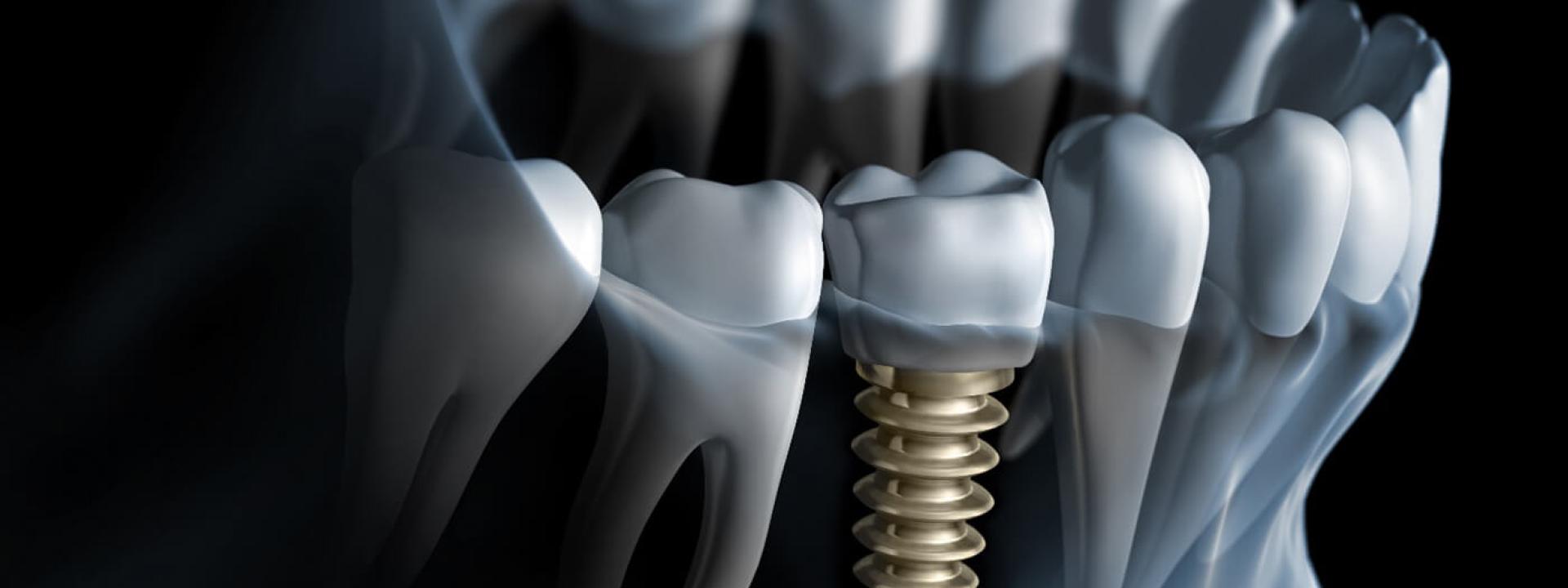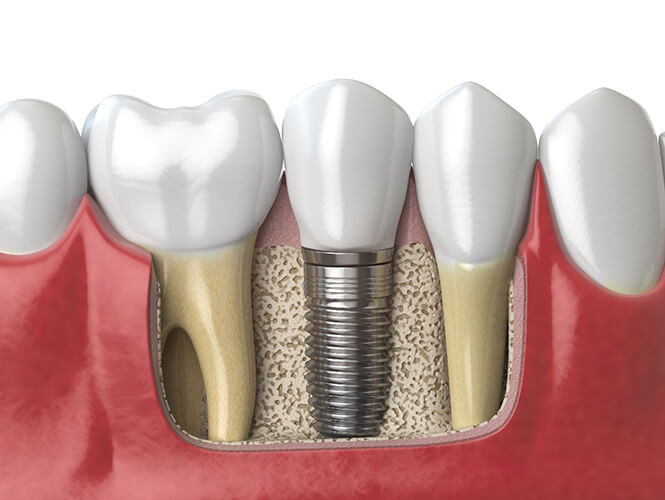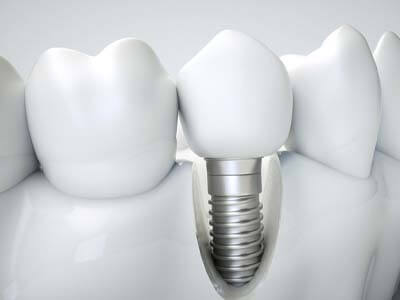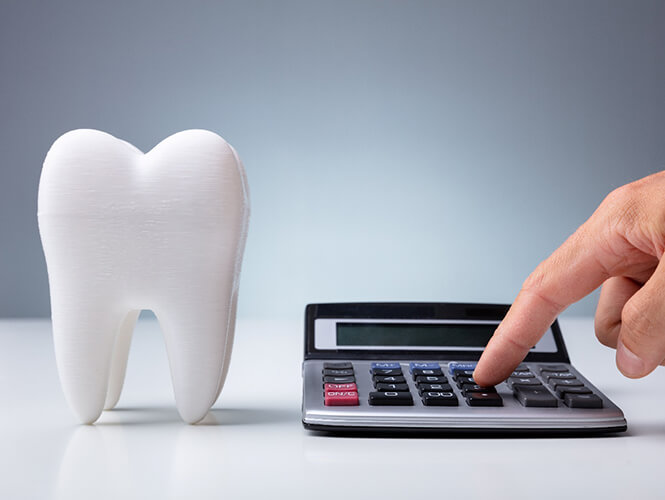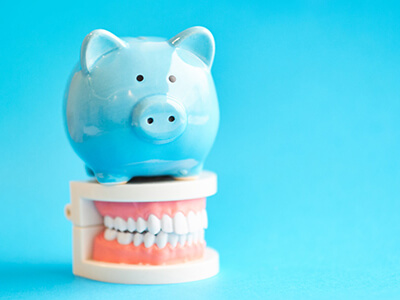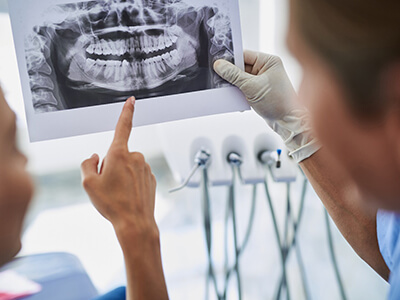What are dental implants and how do they work?
Hi, this is Dr. Matt Rasmussen with Periodontics and Implant Dentistry of Tallahassee. Did you know that there's a permanent tooth replacement option available? Dental implants are a type of procedure that allows an optional replacement of a tooth that's permanent in the mouth, meaning that nothing's going to come in and out, and something you can have for the rest of your life. The dental implant is an actual implant that goes into the bone. There's a metal structure that essentially replaces the root of the tooth that's going to be gone, and eventually, additional components go on there that are called the restorative procedures after everything is completed. So if you'd like to know more about these permanent tooth replacement options, please give us a call at (850) 909-9731.
Who is a good candidate for dental implants?
A common question that we get from patients is, who is a good dental implant candidate? There are a number of factors that play a role, and, of course, you'll need to talk with your dental professional to see about the specifics in your case. But I'd like to hit some of the highlights here. Is there a particular age cutoff for dental implants? The answer to that is no. There are many patients that are older in age that still have adequate health for dental implants and can function with their natural smile and chewing capacity. Now, when would a patient be a dental implant candidate? We need a couple of things that have to be available, the first of which is the anchoring bone that the implant is going to be placed in. We do need adequate bone density at the location to be able to place it for that particular patient. Other health considerations can be taken into consideration as well, as certain things lower the success rate of implants. If someone has diabetes that is not very well controlled, or they've been smoking for a long period of time and smoke a significant amount, like a pack a day, those are considerations you'd want to talk with your doctor about before starting this procedure.
What is the difference between mini implants and full implants?
Another common question that we get in our office is about the difference between what is known as a mini implant and a "full-sized" implant. So, I'll quickly define what each one of those is. A traditional dental implant is a permanent fixture device that's placed in the bone, and that can be used for a number of different purposes. That can be to replace one tooth, it can be to replace a couple of teeth, or there's multiple options even with dentures to help hold them in place, or even stabilize them so they don't even come in and out of the mouth. There is something that's called a mini dental implant. Now, there are certain situations where that can be used, but a mini dental implant, by definition, is a temporary device. It's a smaller one-piece device. So, if there's not any available bone in an extreme circumstance for someone who may need one or two to help hold in a bottom denture, a very elderly patient, we may consider those. But in the vast majority of situations, a conventional dental implant is a dramatically better treatment option available, especially because there's a much higher success rate with a conventional implant as opposed to the mini dental implant.
What is the dental implant process like from start to finish?
Another thing that many patients ask us about is the dental implant process. So, I'd like to briefly go through the dental implant process from start to finish. Now, before I start, I want to give the aspect that our starting point here is now that we have enough bone ready to go to get the dental implant in place. Sometimes there's additional work needed before that, and that would be a separate discussion. But once the dental implant process is ready to go, the dental implant is put into place. That needs to sit and rest while the bone will heal for typically about three to four months in most situations. There are certain circumstances that are extenuating circumstances where that time may be elected to be slightly longer. Once the bone is done, it's healing around the dental implant anchor process. There's a secondary procedure where that is brought into the oral environment. At that point, the bone work is pretty much taken care of. We're just waiting for the gums to heal. And then we're working with the doctor who's putting the teeth on top to do that process as well. So, from start to finish, most dental implants will take from six to 12 months from before the implant is put in to when the person has their final tooth, and they're chewing and smiling with confidence.
How long do dental implants last?
One of the most common questions that I get before talking about a dental implant procedure is, how long do dental implants last? Now, of course, trying to predict something that's going to last 30, 40, 50, 60, 70 years is impossible to predict that far into the future. But dental implants are designed to be a permanent device in someone's body. So, meaning that there's not a specific lifespan and many patients will be keeping those dental implants for the remainder of their life. How do I put myself in the category of the patient that's going to be keeping their dental implant for the rest of their life? Well, there's some quick tips and tricks that we can talk about that can be used to help maintain that dental implant. One of the most common misconceptions about dental implants is that they're installed. And what I mean by that is something is put into place and then it's done. That's not necessarily true. Dental implant maintenance is a key factor in making sure that the patient is able to keep their dental implant long-term, which means consistent visits with their dental professionals, including their surgical specialist and or restoring doctor to make sure that everything is put in place. Also, making sure that the rest of the mouth is healthy is very important because different disease types can travel to the dental implant. But long and short is, a dental implant lifespan can absolutely be the lifespan of the patient, provided that the patient's done their part and the dental professionals have done their part to make sure that all sequences are taken care of in their appropriate manner.
I hope I was able to answer some of the most common questions regarding dental implants. When you're ready to schedule an exam and discuss any additional questions you have, give us a call at (850) 909-9731. We look forward to meeting you.
What are dental implants?
Dental implants are a medical device that is inserted into the jawbone and serves as a tooth replacement. They are usually the best option when a tooth cannot be saved due to severe cavities or cracks.
Why are dental implants the preferred option?
Dental implants are the most natural feeling and least invasive long-term option for replacing a natural tooth.
What is the process for dental implants?
The process involves several steps, starting with the removal of the existing tooth and preparing the area for the future dental implant. This usually involves some bone work. Once the area is ready, the surgical process for the implant is initiated. The restorative doctor then adds the additional components to complete the natural-looking tooth.
During a dental exam for implants
During the dental exam, we examine the whole mouth to ensure the success of any treatments we provide. We may take photos and x-rays and explain the process of dental implants to ensure it is the best option for you.
Conditions that can affect the success of dental implants
Numerous conditions can affect the success rate of dental implants. Our goal at Periodontics and Implant Dentistry at Tallahassee is to provide the best treatment for each individual patient considering their medical conditions.
Te right treatment plan
We work closely with other doctors involved in the treatment and maintain good communication with the patient. We conduct thorough examinations to determine the appropriate treatment level, explain it to the patient, and coordinate with any additional doctors as needed.
Additional steps involved in the process of placing a dental implant
After the jawbone preparation is completed, we place the implant. Once the surgical phase is complete, we move to the restorative phase where we add additional components like the abutment and the cap or tooth replacement.
Bone grafting and dental implants
Bone grafting may be required in situations where we need to add more bone to make the area suitable for the dental implant.
Options for replacing a single tooth
The options include leaving the space open, a dental implant, a bridge, or removable options. The best option in most cases is a dental implant.
Recovery process for dental implants
The recovery process is relatively straightforward with patients reporting soreness for a few days but it rarely interferes with work.
How long do dental implants last?
Dental implants are designed to last for the lifetime of the patient. They are meant to be a permanent device.
Advantages of dental implants
Dental implants will never get cavities and are a more permanent solution than caps.
Cost of dental implants
The cost of dental implants varies depending on the number of implants to be placed. We work with individual lenders to provide financing options for larger scale treatments.
Getting started with dental implants
You should start by discussing it with your regular dentist. If you don't have a regular dentist, we are happy to provide a consultation at Periodontics and Implant Dentistry of Tallahassee. You can reach us at (850) 909-9731
Rebuild Your Smile for Life
If you’re one of the over 120 million Americans who is currently missing at least one tooth, then you’re probably well aware of the headaches tooth loss can cause. In addition to making chewing and speaking uncomfortable or even virtually impossible, it can also be tremendously damaging to your appearance, making you less likely to be social. Thankfully, dental implants now offer a replacement that is the next best thing to nature. With dental implants in Tallahassee, FL, Dr. Rasmussen can close any gaps in your smile and help you reclaim your strong bite for decades to come. To learn more about them and what they could do for you, schedule a consultation today.
Why Choose Periodontics and Implant Dentistry of Tallahassee for Dental Implants?
- All-On-4: Restore An Entire Row of Teeth in One Appointment
- Able to Replace Any Number of Teeth In-House
- Treatment Provided by a Board-Certified Periodontist
What Are Dental Implants?
A dental implant is a small titanium post that is surgically placed into the jawbone beneath the gums’ surface to recreate the root structure of a missing tooth. It is then used to provide support for a new crown, bridge, or denture that shows above the gum line. Once the implant has fully healed, you can expect your replacement tooth to last for many decades and feel almost indistinguishable from your existing teeth. Chewing your favorite foods, smiling with confidence, and performing oral hygiene are simple, seamless, and enjoyable once again. These reasons and more are why dentists recommend dental implants over traditional options every day!
The Dental Implant Process
It’s okay if you don’t have a clear understanding of how the dental implant process works. Dr. Rasmussen is more than prepared to go over each step of treatment with you in great detail so you can know exactly what to expect ahead of time. Every phase of treatment, from the consultation to the attachment of the permanent restoration, will be explained before any surgery is performed. After all, we want you to feel confident about your treatment and your future smile transformation!
The process involves several steps, starting with the removal of the existing tooth and preparing the area for the future dental implant. This usually involves some bone work. Once the area is ready, the surgical process for the implant is initiated. The restorative doctor then adds the additional components to complete the natural-looking tooth.
Why are dental implants the preferred option?
Dental implants are the most natural feeling and least invasive long-term option for replacing a natural tooth.
Initial Dental Implant Consultation
During the dental exam, we examine the whole mouth to ensure the success of any treatments we provide. We may take photos and x-rays and explain the process of dental implants to ensure it is the best option for you.
Placing dental implants requires a fair amount of planning as well as careful examination. Without first looking at your current oral health and the teeth that need to be replaced, we can’t build a proper treatment plan to rebuild your smile. The consultation also provides you an opportunity to ask any questions you may have. We’ll confirm if another treatment would be more appropriate, especially if you have a pre-existing condition that would make dental implant treatment too risky.
Conditions that can affect the success of dental implants
Numerous conditions can affect the success rate of dental implants. Our goal at Periodontics and Implant Dentistry at Tallahassee is to provide the best treatment for each individual patient considering their medical conditions.
The right treatment plan
We work closely with other doctors involved in the treatment and maintain good communication with the patient. We conduct thorough examinations to determine the appropriate treatment level, explain it to the patient, and coordinate with any additional doctors as needed.
Additional steps involved in the process of placing a dental implant
After the jawbone preparation is completed, we place the implant. Once the surgical phase is complete, we move to the restorative phase where we add additional components like the abutment and the cap or tooth replacement.
Bone grafting and dental implants
Bone grafting may be required in situations where we need to add more bone to make the area suitable for the dental implant.
Dental Implant Surgery
Before beginning, we will ensure that you are numb, comfortable, and ready to begin your surgery. We’ll also administer sedation if you requested it ahead of treatment. Next, Dr. Rasmussen will create a tiny incision in your gums to access your jawbone. Then, he will make a small hole in the bone for the placement of your implant. After the implant has been placed, he’ll close the gum tissue up with stitches so the implant can start to heal and integrate. Before you leave, he’ll go over the best aftercare steps to ensure no complications appear during your recovery.
Dental Implant Osseointegration & Abutment
Once the dental implants are placed, you’ll leave our office to begin a 4 to 6 monthlong healing period. This is known as osseointegration and it’s designed to give the implant time to fuse with the jawbone. Thanks to the titanium post, the human body can receive it safely, much like implants in other parts of the body (such as the hip).
When the implant has fully fused, an abutment can be attached. This small cap is meant to provide additional stability to the restoration. To place it, Dr. Rasmussen carefully opens the gum tissue to expose the implant, then places the abutment and stitches the gums closed one more time. The gums will then begin to heal around the abutment over the next few weeks.
Recovery process for dental implants
The recovery process is relatively straightforward with patients reporting soreness for a few days but it rarely interferes with work.
Delivery of Dental Restoration
After this is complete, you’ll come back into our office, where Dr. Rasmussen will place your permanent crown, bridge, or denture on top of the implant to restore your entire tooth from the roots up. The restoration will be customized to not only look natural from all angles, but keep the bite as even as possible. Your replacement tooth is created by a trusted dental lab outside of the office, so you can expect it to last for decades and even reflect light similarly to natural enamel.
Benefits of Dental Implants
Dental implants are very different from traditional bridges and dentures that just sit on top of the gums. Instead, Dr. Rasmussen places small titanium posts into the jawbone that act as artificial tooth roots, and these are used to support the new teeth. This approach brings with it a host of advantages. The benefits of dental implants are many, and you won’t find another tooth replacement solution that offers the same level of success, functionality, and stability. Dental implants will never get cavities and are a more permanent solution than caps. To prepare for your new prosthetics, check out the unique advantages you can expect from dental implants! If you have any questions, please don’t hesitate to contact our office !
Day-to-Day Benefit
Self-Stabilizing: Implanted teeth sit within strong jawbone just like real ones, enabling a patient to eat whatever they like without having to deal with slippage or breakage.
Aesthetically Pleasing: Every implant post is topped with a 100% custom-made restoration, and because implants don’t require unnatural-looking attachments to stay in place, this gives them a lifelike appearance that blends into anyone’s smile.
Minimal Maintenance: Dental implants can be cleaned using a soft-bristled toothbrush, non-abrasive toothpaste, dental floss, and regular mouthwash. This makes them easier to maintain and keep clean year after year.
Better Quality of Life: You will embrace a better quality of life with dental implants because you can freely talk, eat, and smile with ease. Denture-wearers are often embarrassed by their prosthetics and avoid many social gatherings. But with dental implants, you never have to worry!
Health Benefits
Natural Teeth Remain Untouched: Unlike a dental bridge that requires altering your abutment teeth on either side of the gap, dental implants are placed in the vacated socket, leaving your natural teeth untouched.
Bone Preservation: The jawbone tends to atrophy after tooth loss, but implants can help stimulate the bone and lead to the growth of new tissue right where it’s needed. This ensures the remaining teeth stay strong and the facial muscles always have adequate support (which can prevent the formation of wrinkles).
Improved Overall Health: It is not uncommon for tooth loss to cause more serious health-related issues such as osteoporosis, diabetes, and heart disease. By replacing your teeth with dental implants, you reduce your risk and save money on various medical treatments.
Long-Term Benefits
High Success Rate: It is believed that when dental implants are placed by a skilled Periodontist, they have a success rate of around 95%. If they are properly maintained, they can continue to have a success rate of 90-95% after 10 years!
Reliable: When placed by a specially-trained dentist like Dr. Rasmussen, implants can easily endure for multiple decades, often lasting for the rest of a patient’s life!
Money-Saver: Surprisingly, dental implants can save you a lot of money over the course of your lifetime. Instead of buying denture adhesives and special cleaning supplies as you would with traditional dentures, you can choose permanent prosthetics. Also, you won’t need to worry about frequent adjustments or replacements every 5-10 years like you would with traditional dental bridges or dentures.
Who Dental Implants Can Help
In order to be a good candidate for dental implants, a patient needs decent oral health and a jawbone strong enough to support the new roots. If either of these is lacking, Dr. Rasmussen can help (see “Advanced Dental Implant Procedures” below). Once he determines that a patient’s mouth is in good enough shape to safely receive implants, he can place the posts, which can be paired with a variety of restorations depending on a patient’s needs.
Missing One Tooth
A single implant can be placed into the jawbone between two healthy teeth and topped with a porcelain crown without disturbing the nearby dental structure at all. This is much less invasive compared to a bridge, in which the neighboring teeth have to be filed down to support the prosthetic.
Missing Multiple Teeth
For consecutive missing teeth or those located throughout the mouth, implants can also serve as the foundation for a bridge or partial denture. This gives the prosthetics a strength and security removable ones simply can’t match.
Missing All Teeth
Even people missing all of their teeth along a single row can benefit from implant dentistry. Using a small number of implant roots, a full denture can be anchored to the jawbone that looks better, provides a stronger bite, and lasts longer than any traditional one.
Understanding the Cost of Dental Implants
There’s no one answer when it comes to the ultimate price of dental implants. The procedure will be different for everybody depending on their situation, and as such the cost will vary as well. At the start of the process, Dr. Rasmussen will schedule an in-person consultation in order to examine and discuss the various factors that could affect the final amount you’ll pay. Call Periodontics & Implant Dentistry now to start the implant process and learn the true cost of a complete smile.
Preliminary Treatments & Dental Implant Surgery
Some patients may require certain preliminary treatments to ensure successful treatment. Although these procedures (i.e., gum disease therapy, tooth extractions, bone grafting) will add to the overall cost, they’re crucial for maximizing the success of your new smile. Luckily, these are often partially covered by dental insurance.
It’s important to note that dental implant surgery has a cost of its own. Since we’re able to provide the entire treatment under one roof, you don’t have to worry about visiting a separate facility or paying a different bill. We can handle it all at our practice!
The Parts of Your Dental Implant
When calculating the total cost of dental implants, you should remember that there are multiple factors that affect the overall price. Some of those include:
Number of Implants. Depending on how many teeth you’re missing, you may need anywhere from one to six dental implants. As you can imagine, the more you need, the higher the cost will be.
Type of Restoration. Dental crowns, bridges, and dentures all have different costs. The smaller the restorations are, the less expensive they’ll be. Some implants are made of zirconia instead of titanium, which affects the total price. Different manufacturers produce implants that cater to the diverse needs of patients. The brand you choose can influence the cost of the implant, so make sure you inquire about the source of your implant and any brand-specific benefits.
How Dental Implants Can Save You Money
While dental implants initially seem to cost more than other kinds of tooth replacement, they’re certainly worth the price. Not only do they look and feel natural while letting you chew all your favorite foods, but they can also prevent resorption in the jaw (the natural consequence of losing teeth).
Unlike other restorations, dental implants can potentially last the rest of your life. This can make them the most cost-effective option since you won’t have to pay for new ones nearly as often. Of course, if you want to make sure you get the most out of your investment, you should make sure your implants are being placed by an expert. Fortunately, Dr. Rasmussen is a board-certified periodontist who is well-experienced in performing this particular procedure.
Does My Dental Insurance Cover Dental Implants?
Many plans won’t pay for implants, but others might; it all depends on who your carrier is. Bear in mind that even if your insurance won’t pay for the implants themselves, it may help cover certain related procedures such as treatment for gum disease. Our practice offers in-network savings, but we’re more than happy to file a claim for an out-of-network provider or offer third-party financing through CareCredit, Alphaeon or Proceed.
Making Dental Implants Affordable
Don’t have dental insurance? That’s okay! We offer additional financing options to help make your dental implant treatment affordable. We can help you sign up for third-party financing with CareCredit, Alphaeon or Proceed, which offers low-interest rates. It can make the cost of any treatment fit within your budget. Additionally, you can currently take advantage of our $99 new patient special!
Dental Implant Technology
A dentist’s or periodontist’s skill is one of the most important factors in whether or not a dental implant procedure is successful. However, dental implant technology also plays a key role. Innovations in the tools used during treatment planning and execution allow for more precise procedures, more efficient surgery, and a lower risk of complications. Below, you will find information about just a few of the instruments and techniques that Dr. Rasmussen uses to promote positive outcomes for his patients.
3D Cone Beam Imaging/3D CT Scanning
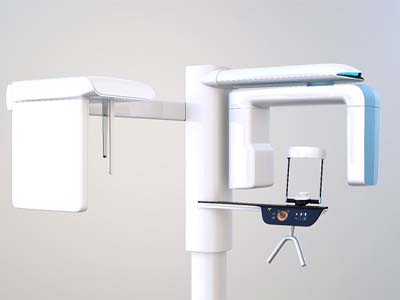
A cone beam scanner, also called a CBCT scanner or 3D CT scanner, is basically a super-powered X-Ray. It uses a cone-shaped beam of radiation to capture highly detailed images of your oral structures. It is much more precise than a regular digital X-Ray and provides our team a comprehensive view of your teeth, jawbone, nerves, and connective tissues.
Using this type of 3D imaging, Dr. Rasmussen is able to create a highly detailed model of a patient’s jawbone and surrounding oral structures. This helps him take all the guesswork out of someone’s implant placement procedure. He can identify the perfect locations within the jawbone for the new tooth roots, determine the thickness of the bone, and even figure out the angle the implant should be placed at to provide the strongest foundation possible for the new teeth. By the time the actual procedure starts, a positive result is practically guaranteed.
The scanning process with a CBCT machine is fast, noninvasive and painless. After our team positions you in the machine, all you have to do is stay still while the scan is performed (usually in under one minute). You won’t have to do anything special to prepare for your scan, except perhaps remove jewelry or other objects that might interfere with the accuracy of the final images.
Guided Dental Implant Surgery
Many dentists use freehand techniques to place dental implants. In most cases, freehand placement is successful. However, if a patient requires multiple implants or has other complicating factors, freehand surgery comes with an increased risk of problems.
That is why Dr. Rasmussen , your implant dentist, often uses guided surgery techniques. Using a custom surgical guide from a trustworthy dental laboratory, he can place your prosthetic tooth roots precisely where they belong, inserting them at the correct location, angle, and depth. This reduces the risk of post-op complications and can even shorten patient recovery time.
The guided surgery process takes longer and requires more preparation than freehand implant placement. However, it is often a pivotal part of successful treatment. If you are missing multiple teeth or have other concerns that might make your treatment more complex than an average dental implant procedure, it is especially important that you partner with a doctor who offers guided surgery.
Would you like to learn more about the advanced technology that our team uses to support your journey toward improved oral health? Contact us today to ask questions or request an appointment.
Advanced Dental Implant Procedures
To become a periodontist, Dr. Rasmussen had to complete years of specialty training on top of dental school that was specifically dedicated to placing dental implants. Because of this, he’s able to use the latest technology and help many patients who typically wouldn’t be able to get implants using various bone grafts. This enables even more people to enjoy the most complete tooth replacement available today. Read on below to learn about some of the advanced dental implant procedures, dental patients that can rebuild your smile.
Bone Grafting
 Once a tooth goes missing, the jawbone in the area slowly starts to shrink and atrophy. This is because the body senses that there is no tooth to support, so it begins to resorb nutrients directly from the bone. This can make it too thin or brittle to support dental implants. With a bone graft, however, Dr. Rasmussen can use a patient’s own bone, donated bone, or a lab-made grafting material to reverse this process and encourage the growth of new, healthy tissue. A bone graft can usually be completed in a single appointment, and after just a few months of healing, a patient who previously wasn’t able to get dental implants will now be ready to receive their new roots.
Once a tooth goes missing, the jawbone in the area slowly starts to shrink and atrophy. This is because the body senses that there is no tooth to support, so it begins to resorb nutrients directly from the bone. This can make it too thin or brittle to support dental implants. With a bone graft, however, Dr. Rasmussen can use a patient’s own bone, donated bone, or a lab-made grafting material to reverse this process and encourage the growth of new, healthy tissue. A bone graft can usually be completed in a single appointment, and after just a few months of healing, a patient who previously wasn’t able to get dental implants will now be ready to receive their new roots.
3D Imaging
Using 3D imaging, Dr. Rasmussen is able to create a highly-detailed model of a patient’s jawbone and surrounding oral structures. This helps him take all the guesswork out of someone’s implant placement procedure. He can identify the perfect locations within the jawbone for the new roots, determine the thickness of the bone, and even figure out the angle the implant should be placed at to provide the strongest foundation possible for the new teeth. By the time the actual procedure starts, a positive result is practically guaranteed.
Bone Regeneration
In addition to the gums themselves, gum disease can also break down the underlying jawbone that supports the hard and soft tissues of the mouth. This is largely why gum disease is the leading cause of adult tooth loss in the U.S! For patients who have experienced this, bone regeneration is used to build the jawbone back up so it can be strong and thick enough to support an implant. A collagen membrane is applied directly to the bone where it needs to grow, and this material stimulates the generation of new tissue exactly where a patient is lacking.
Ridge Preservation
Often, before a patient receives dental implants, any broken or decayed teeth have to be removed. In order to ensure that implants can be placed as quickly as possible after an extraction, the surrounding bone must be looked after. Ridge preservation is a procedure that helps protect and strengthen the nearby jawbone that used to support a tooth so it will be thick enough to hold an implant. Depending on a patient’s specific situation, this treatment can be performed on the same day as an extraction.
Dental Implant Salvage
Even if your dental implant fails, something that is extremely unlikely to happen when you practice routine oral hygiene, there are ways to save it and prevent the need from removing it outright. Our office is prepared to confirm any problems and create a treatment plan that works to restore your smile.
Learn More About Dental Implant Salvage
Dental Implant FAQs
Many, many people are interested in getting dental implants to replace their missing teeth, but they’re full of questions. If this includes you—great! Just considering this treatment is a huge step forward and shows that you are taking your oral health seriously. Below, you’ll find answers to some of the frequently asked dental implant questions our team receives every day. For questions that haven’t been touched on here, be sure to give us a call and ask!
Are dental implants better than traditional bridges/dentures?
The answer to this really depends on the patient and their specific situation, but side by side, dental implants offer the most natural-looking, secure, and reliable tooth replacement compared to every other treatment. If a patient is a good candidate for them, Dr. Rasmussen always highly recommends implants.
How long does it take to get dental implants?
This can vary depending on a patient’s oral health and how many teeth they would like to replace. Simple cases that involve a single tooth can often be completed in four to six months, while more complicated ones that include replacing several teeth with a denture may take closer to a year. To learn what your particular timeline will be like, we need to see you for an in-person consultation.
Does getting dental implants hurt?
Most patients describe feeling very little during the placement procedure thanks to local anesthetic, though a little soreness and swelling is common afterward. This can usually be managed with over-the-counter pain medication and will quickly subside, and most patients are able to resume their normal routine within a few days.
Why should I visit a periodontist to get dental implants?
Periodontists like Dr. Rasmussen have received training specifically dedicated to placing dental implants, unlike many general dentists. When you visit Dr. Rasmussen, you can trust he has performed whatever procedure you need countless times before and already used it to help innumerable patients recover their missing teeth. He’s also able to provide many advanced services that will make the treatment process faster, more comfortable, and more successful.
Dental Implants Post-Op Instructions
Once your dental implants are surgically placed, you’ll need to undergo a recovery process to avoid any complications and create the most comfortable healing period possible. The good news is the aftercare following dental implant treatment is relatively straightforward when you know the most important steps. While our office will go over all post-op instructions before you leave, you’re encouraged to read about them in more detail on our website as well!
What to Do Directly After Dental Implant Surgery
After your implant surgery, you’ll need to take good care of your implant site to ensure the blood clot does not become loose or fall off. To do this, keep the following tips in mind:
- Avoid spitting, especially with excessive force. Swallow your saliva or use tissues to clean yourself up.
- Avoid drinking out of straws.
- Do not consume any tobacco products for at least a day.
- Do not touch the treatment site, either with your fingers or your tongue.
Common Side Effects
Side effects following dental implant surgery are relatively normal. For example, you are likely to experience the following:
- Intermittent bleeding – This can be mitigated by applying light pressure to the area with a gauze pad. Don’t be alarmed as light bleeding is normal over the next few days.
- Facial swelling – Swelling is common for the next 72 hours after surgery and can be reduced by applying a cold compress to your face.
- General discomfort – Take prescription medication as recommended by the instructions labeled on the bottle.
Diet
Over the first few days after surgery, sticking to a soft diet is key to preventing any complications or stress to the implant site. Non-abrasive foods to consider include:
- Yogurt
- Ice cream or pudding
- Cooked cereals (let them get to room temperature first)
- Applesauce
- Scrambled eggs
- Soft-cooked pasta, beans, and vegetables
- Mashed potatoes
- Cold or room temperature soups and stews
As soon as you’re feeling comfortable, you may resume a normal diet after you’ve given your mouth time to heal over the next few days. We do not recommend eating any hard, tough or chewy foods. Avoid chewing directly on the implants for now.
Health & Oral Hygiene
You may brush your teeth as normal the day after your surgery. Just use extreme caution when you do to prevent disturbing the treatment site. Use a saltwater mixture (or medicated oral rinse if provided) to rinse your mouth out two to three times a day, especially after meals. Avoid any mouthwashes that contain alcohol as these can cause dry mouth and put your implant at risk.
What to Do After Your New Teeth Are Attached
Once you’ve healed completely, the hardest part of your tooth replacement process is over! After your restoration is attached, whether it’s a crown, bridge, or denture, you may notice some minor sensitivity over the next few days. You can manage this with pain medication as needed. However, if you notice any bleeding, swelling, or other concerning side effects following the placement of your restoration, call us immediately.

Maintaining & Caring for Your Dental Implants
Whether you’re thinking about dental implant treatment to replace missing teeth or you just got out of surgery, you can expect your new smile to last for many decades without concern. However, like any long-term investment, you’ll want to make sure you take proper care of it moving forward. If you are unfamiliar with what dental implant aftercare looks like, Dr. Rasmussen is here to answer your questions. If you have yet to set up an implant consultation or you need to complete a follow-up exam for your current implants, give our office a call!
Make Oral Hygiene a Priority
It’s true that dental implants hold restorations that are made from inorganic material (porcelain), which means they cannot develop decay like natural enamel can. However, that does not mean you can skip your oral care routine. Bacteria can still attack the gum tissue surrounding the implant, further proving the importance of maintaining brushing and flossing every day.
To ensure the best oral care routine possible, make sure to:
- Brush twice a day for at least two minutes at a time
- Use fluoridated toothpaste to kill cavity-causing bacteria
- Floss once a day to remove food debris stuck in between teeth (and from the area underneath the restoration)
- Use an optional oral rinse for added protection
- Make sure not to brush too hard as this can cause gum recession
Protect Your Dental Implants
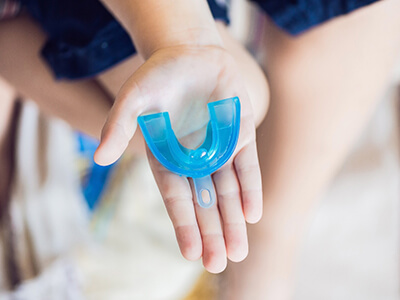
Dental implants are made from high-quality, durable, and lifelike porcelain to ensure the best longevity possible for your tooth replacement. However, that does not make them indestructible. Much like natural teeth, implant restorations need to be regularly protected from forced sudden trauma or long-term habits that can break them down. This includes injuries that could occur while playing contact sports or habits like teeth grinding and clenching (also known as bruxism.)
The good news is you can easily avoid permanent damage to your replacement teeth by wearing a mouthguard or nightguard, depending on your needs. Ideally, you’ll want to choose a custom-made nightguard as they are far more effective at protecting teeth, last longer, and feel more comfortable overall compared to store-bought solutions. Our office will gladly partner you with a trusted dentist in the area to design your future oral appliance.
Schedule Regular Dental Checkups
Even if there are no issues with your dental implant, it is still crucial that you maintain routine follow-up appointments with our office immediately after your implants are placed. These visits are separate from the routine exams and cleanings you are already doing every six months. Not only can Dr. Rasmussen confirm the health of your dental implant, but he can also make sure if there are any signs of trouble that need to be addressed.
Once your implant is placed, we need to make sure that the healing process goes as planned and that your mouth does not reject the implant after it’s attached to the jawbone. Furthermore, we want to confirm that no underlying symptoms (i.e. inflammation, swelling, gum recession etc.) are present, all which are signs of a dental infection caused by the implant. Even though this is unlikely to occur, it’s better to be safe rather than sorry.

